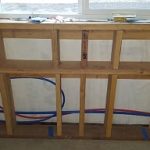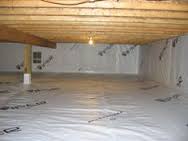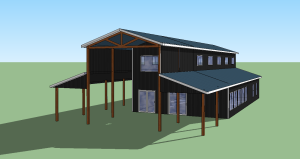When I began writing these articles a few short years ago, I assumed I would run out of subject matter after about 100 or so. Silly me – as I’ve now produced in excess of 1100 of them and I keep realizing I have totally skipped over some obvious subject matter.
One of those which has been totally missed by me is rebar hairpins.
So, what is a rebar hairpin?
A rebar hairpin is a piece of rebar (https://www.hansenpolebuildings.com/2016/01/rebar/) , in the case of a Hansen Pole Building, ½ inch in diameter and five feet in length. An oversized (5/8 inch diameter) hole is drilled through each column, 1-3/4 inches above grade and two inches in from the outside column face. The rebar is inserted into the column so an equal distance remains outside of each end of the hole.
The two rebar ends are then bent towards the interior of the building, at a 45 degree angle to the pressure preservative treated splash planks. When the nominal four inch thick concrete slab is poured inside of the building, the hairpins will be in the middle of the slab’s depth – effectively tying the columns and the concrete floor together.
Why might the hairpins be important?
Embedment formulas.
Not baby, or racing formulas.
Part of the calculations for every post frame building should be those for column embedment. There are two conditions of embedment – non-constrained, where the building will never have a concrete floor or the concrete floor and the columns will be affixed to each other. The other condition would be constrained where the building columns are “constrained” from lateral motion due to the contribution of the concrete slab on grade.
There are cases where the building columns being constrained can actual save money (sometimes significant amounts). This is due to the shear forces the building must resist are reduced to 75% from the contribution of the slab constraint.
When wind forces are relatively high, building is tall and/or the building length to width ratio is large, the savings in column sizes and additional materials for shearwalls can amount to significant savings.
Hairpins also function, in frost country, to keep the columns and slab from being moved at different rates due to the forces of frost. This should be negligible on a properly prepared building site.
And there you have it… everything you wanted to know about rebar hairpins, and a little more.










great article, and ALMOST everything you wanted to know about hairpins. What if you’re using Perma-columns in your barn? do you still need hairpins? and if so, how do you attach them? do you drill thru the column like a wood column? Could you wrap around the outside of the Perma-columns? thanks in advance.
John
You would not “have” to use hairpins with Perma-columns. however without them it will increase the shear load intensity in the roof by 1/3rd. You could wrap them around the exterior of the Permacolumn – the whole concept being to eliminate outward lateral movement of the assembly.
In my case I’m using the PermaColumn SturdiWall Plus brackets. Should I put hairpins through the middle of the 4 rebars that extend down into the concrete piers?
Hi Dave,
The rebar hairpins would go through an embedded column, into the slab. In a case with Wet-Set brackets, there are no hairpins. If you have further questions regarding your building, please email techsupport@hansenpolebuildings.com for the quickest response.
Thank you